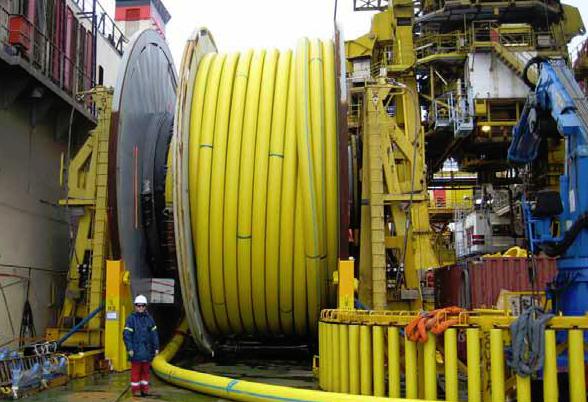
Some say that the last great hydrocarbon deposits lie within the Arctic Circle, and if so, it’s going to place extra demands on those extracting them, such as Technip Canada, Alan Swaby learns.
Technip has built a reputation for technological advancement in a challenging environment and for creating and developing employment and business opportunities for the people of Atlantic Canada. Sam Allen, president of Technip in Canada helped open the Technip office in St. John’s 13 years ago, when the Terra Nova oil field was being developed 350 kilometers off the coast of Newfoundland. “Technip was part of the Grand Banks Alliance,” he explains, “which at the time was the most comprehensive Alliance of its kind ever put together.”
As one of the world’s leading suppliers to the oil and gas industry, Technip has been involved with most major developments in one capacity or another. Last financial year it generated around €6.5 billion worldwide. Technip operates in three segments of the world oil and gas market: Subsea, Offshore and Onshore. Onshore, Technip builds petroleum processing—it’s the world’s largest designer of liquefied natural gas plants, for example—and offshore it engineers production platforms. In Canada, Technip’s principal interest is subsea components.
Listed on the Paris Stock Exchange, Technip is a truly global company with nearly half of its workforce in Europe, 22 percent in Asia Pacific, 21 percent in the Americas, 7 percent in the Middle East and 3 percent in Africa. Canada falls under the North Sea and Canada sector, which also includes the United Kingdom and Norway.
As project managers and engineers, the normal mode of operation is to decentralize and open an office as close as possible to the project. In Canada’s case, the current offshore oil fields are some 350 kilometers out into the Atlantic. The next generation will be even farther out and at water depths of 2,000 meters, but at the moment Technip is working on the Grand Banks, where the seas are not particularly deep (around 100 meters). But this in itself creates another set of problems. Such vast amounts of water compressed into relatively shallow areas can generate waves of 30 meters at times of bad weather—of which there are plenty.
Shallow seas combined with extreme environmental conditions of low temperatures and high winds make the design of the subsea equipment that Technip supplies a particular challenge.
Icebergs are also a real threat in that area. In the same way that platforms have to be capable of being disconnected and shut down in times of hurricanes, so too with icebergs. Smaller chunks of ice can be deflected by water cannons, but larger masses often have to be lassoed and towed to where the currents miss the workings.
Wellhead equipment often has to be located below the level of the sea bed, out of the reach of icebergs in what are commonly referred to as glory holes—purpose-built 10-meter-deep depressions the size of a football field. One, on the White Rose field, measured 58 meters by 50 meters—a significant undertaking below 110 meters of water and in boulder-strewn, rock-hard substrate.
In Canadian waters, Technip has been involved to some degree with every project to-date. Technip will typically supply the pipelines that transport the hydrocarbons from the wellhead to the production facility and the umbilicals that control the wellhead equipment. Technip will also perform all the associated offshore construction works including, for example, the installation of the associated manifold equipment and the mooring system for the production facility.
It’s worth reminding ourselves what is being asked. Oil can leave the well at 5,000 pounds per square inch pressure and 100°C temperature. The flowlines can measure hundreds or thousands of meters in length, but in all cases they must provide a working life of at least 20 years in very onerous conditions. Take a cross-section through a typical 8-inch internal diameter flow-line and you’ll find 4-inch-thick walls made from layers of stainless steel, plastic, insulation and reinforcement, none of which can be allowed to fail. Take a cross-section through an umbilical line and you’ll find hydraulic hoses, power cables and signal wires aplenty. In Technip’s case, it has plants in France, Brazil, the UK, the USA, West Africa and Malaysia dedicated to manufacturing these high technology products. The Group’s subsea flexible pipe R&D center is based in France.
“Obviously,” says Allen, “there are other suppliers who can produce individual items, but the advantage we have at Technip is our vertical integration. Not only do we have the engineering skills and proven functional components and systems; we also have the infrastructure and resources to handle installation and commissioning as well as supply.”
In Canada, the other source of petroleum is from the oil sands, where Technip also has a presence. “Activity has been slow for a few years,” Allen says, “after it overheated in 2007, but there are signs that demand is on the rise once more.”
But it’s in Newfoundland in particular that the oil and gas industry has transformed the province. Thirteen years ago it was the poor relative, with a gross domestic product of just 89 percent of the Canadian average; these days it’s running at 110 percent of the average. And as one of the few contractors that have been there continuously for the whole period, Technip has played a significant role in raising prosperity and shifting attitudes. “On the next major project, for example,” says Allen, “40 percent of the project management and engineering team will be female.”
All players in the oil and gas industry will continue to be highly conscious of the responsibility they have to safeguard the environment and exercise due diligence as health and safety of their workers and the environment is, and will always be, the number one priority.













